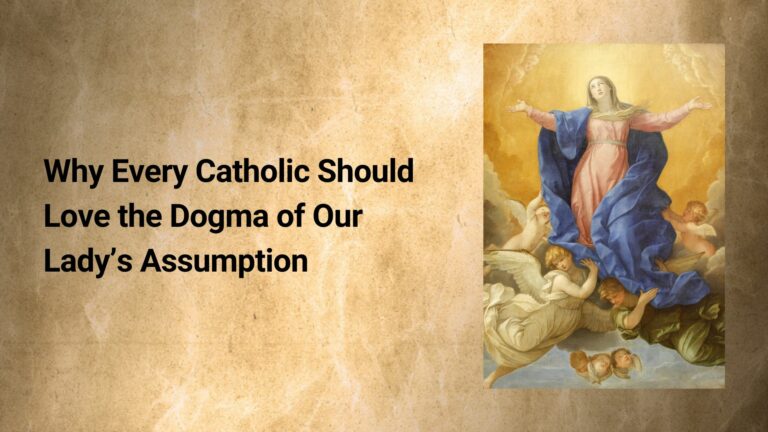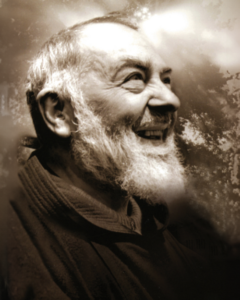
How I Came to Accept and Love Suffering
By James Bascom
August 15, 2025
This year marks the seventy-fifth anniversary of Pope Pius XII’s declaration of the dogma of the Assumption of Our Lady. With the Apostolic Constitution Munificentissimus Deus (“Most Bountiful God”) on November 1, 1950, Catholics around the world were overjoyed when Pope Pius XII solemnly proclaimed the dogma that Mary Most Holy was assumed body and soul into Heaven, the only human to receive this privilege. It was a glory for the Mother of God and the Universal Church that the Pope defined and elevated this beautiful teaching to the highest honors. Like all Church teachings, it has a rich history and theology that should fill all Catholics with joy and inspire them to have an even greater devotion to Mary Most Holy.
Our Lady’s Assumption took place sometime after Christ’s Ascension into Heaven. Since she was conceived without Original Sin she was exempt from death, but nevertheless she wished to imitate Him in absolutely everything. Her death is referred to as her Dormition, as it was such a peaceful death that it appeared more a deep sleep than a death. She is traditionally portrayed dying with the Apostles in mourning around her. Shortly after God resurrected her and she was assumed into Heaven body and soul.
The belief in the Assumption is as old as the Church herself
Although not explicitly mentioned in Scripture, Our Lady’s Assumption is a very ancient teaching contained in Church Tradition. As Pius XII wrote, “the dogma of the Virgin Mary’s Assumption into heaven is contained in the deposit of Christian Faith entrusted to the Church.”[1] Saint Peter and the Apostles passed this truth of the Faith to their successors. References to the Assumption can be found in the liturgical rites in both the East and the West, indicating an ancient belief in this doctrine.
Unlike nearly every other saint, there is no historical evidence that the Church possessed or promoted bodily relics of the Blessed Virgin. This shows that the early Church believed that Our Lady was assumed into Heaven body and soul.
As Pope Pius XII points, many Church Fathers and saints from the early Church preached this doctrine, including Saint John Damascene (675-749 A.D.) Saint Germanus of Constantinople, and Saint Gregory of Tours (538-594 A.D.). Saint John Damascene in particular stands out as one of its great defenders. When Pope Leo XIII made him a Doctor of the Church, the Pope called him the “Doctor of the Assumption.”
From the Middle Ages to the modern era, many saints have defended this doctrine including Saint Albert the Great, Saint Anthony of Padua, Saint Thomas Aquinas, Saint Francis of Assisi, Saint Bernadine of Sienna, Saint Robert Bellermine, Saint Alphonsus Liguori, and Saint Peter Canisius, among many others. The support for the Assumption is so overwhelming that, as Pius XII writes, “those who deny that Mary’s body has been assumed into heaven are not to be listened to patiently but are everywhere to be denounced as over-contentious or rash men, and as imbued with a spirit that is heretical rather than Catholic.”
In fact, the Assumption is a refutation to certain Gnostic heresies in the early Church that saw all matter as evil and therefore denied Our Lord’s humanity and His birth of a Virgin. Our Lady’s Assumption which followed Christ’s Ascension into Heaven affirms the inherent goodness of the material world. If matter were evil, then a material body could not enter heaven.
______
[1] Munificentissimus Deus, 8
Our Lady’s Assumption is intimately linked to her Immaculate Conception
Just as many saints and theologians believed in the Assumption, so too did many believe in the Immaculate Conception. In fact, the two Marian doctrines are intimately linked, with the former a natural consequence of the latter.
As Pius XII explains, Christ conquered sin and death with His own death. The general rule is that the just still must suffer death and the corruption of the body until resurrection of the living and dead at the end of the world. Our Lady, however, was exempted from this rule due to her Immaculate Conception. By a unique privilege, “she was not subject to the law of remaining in the corruption of the grave, and she did not have to wait until the end of time for the redemption of her body.”
In a sermon on the subject, Saint John Damascene wrote:
“It was fitting that she, who had kept her virginity intact in childbirth, should keep her own body free from all corruption even after death. It was fitting that she, who had carried the Creator as a child at her breast, should dwell in the divine tabernacles. It was fitting that the spouse, whom the Father had taken to himself, should live in the divine mansions. It was fitting that she, who had seen her Son upon the cross and who had thereby received into her heart the sword of sorrow which she had escaped in the act of giving birth to him, should look upon him as he sits with the Father. It was fitting that God’s Mother should possess what belongs to her Son, and that she should be honored by every creature as the Mother and as the handmaid of God.”
Saint Robert Bellermine, Doctor of the Church, exclaimed: “And who, I ask, could believe that the ark of holiness, the dwelling place of the Word of God, the temple of the Holy Spirit, could be reduced to ruin? My soul is filled with horror at the thought that this virginal flesh which had begotten God, had brought him into the world, had nourished and carried him, could have been turned into ashes or given over to be food for worms.” Saint Alphonsus Liguori writes that “Jesus did not wish to have the body of Mary corrupted after death, since it would have redounded to his own dishonor to have her virginal flesh, from which he himself had assumed flesh, reduced to dust.” And Saint Albert the Great wrote: “From these proofs and authorities and from many others, it is manifest that the most blessed Mother of God has been assumed above the choirs of angels. And this we believe in every way to be true.”
The Mystical City of God by Venerable Mary of Agreda had visions of Our Lady’s dormition and assumption. She described the how Our Lord Himself, her son, came personally to escort her to Heaven, “amid incredible rejoicing and admiration, rilled Her with splendor and glory in the sight of the angels and saints.”
In our times, devotion to Our Lady’s Assumption should give us hope and strength in our battle against evil. This blessed doctrine, so intimately linked to the Immaculate Conception, is a reminder of her immense privilege as Mother of God and Queen of Heaven and Earth that she will crush the head of the serpent. Adam and Eve were cast out of the Garden of Paradise for their sin. Our Lady, as the New Eve, was taken into Heaven to remain forever with Her Divine Son. Her Assumption into Heaven was a sign to humanity of what the just can expect at the end of time, when their bodies will Resurrect to join their souls and enjoy the presence of God for all eternity. By Assuming into Heaven, Our Lady proclaimed her final and overwhelming victory over Satan.
Dear ,
August 15 is the feast of Our Lady’s Assumption into Heaven, that glorious Marian doctrine that God took her body and soul directly into Heaven. What a beautiful privilege of the Mother of God!
Although the Fathers and Doctors of the Church have taught this doctrine since the early Church, it was only elevated to a dogma on November 1, 1950, when Pope Pius XII published the Apostolic Constitution Munificentissimus Deus (“Most Bountiful God”). This year, in fact, marks the seventy-fifth anniversary of this important document.
From Saint John Damascene to Saint Thomas Aquinas, Saint Francis of Assisi, and Saint Alphonsus Liguori, many saints preached this marvelous doctrine through history.
The Assumption should inspire us to have a greater love for the Blessed Virgin Mary, and a greater confidence that she will help us and protect us in this time of sin of confusion.
Read this article Why Every Catholic Should Love the Dogma of Our Lady’s Assumption.
Until next time,
Sincerely.

